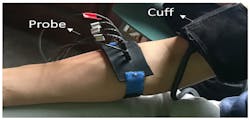Knowing that stroke is caused by poor blood flow to the brain (cerebral ischemia) and must be diagnosed within the first few hours of the stroke's occurrence to be effective, a team of researchers from the Army Medical University (Chongqing, China) and the China Academy of Engineering Physics (Mianyang, China) has developed a device that uses near-infrared (near-IR) light to monitor blood flow. The device, which relies on the combination of two optical spectroscopy techniques, could be used to quickly and noninvasively diagnose cerebral ischemia.
Liguo Zhu, an author on the study, says that the instrument works thanks to near-IR diffuse optical spectroscopy, which analyzes light scattered from tissues to calculate the amount of oxygen and blood within an area, and diffuse correlation spectroscopy, which analyzes fluctuations in tissue-scattered light to measure the rate of blood flow, or blood flow index.
"We can measure blood volume, blood oxygenation, and blood flow using suitable near-IR techniques," Zhu says, adding that near-IR light penetrates 1 to 3 cm and allows researchers to probe under the skin.
To test their instrument, the authors strapped a device probe to a human subject’s forearm, then inflated an arm cuff around the subject’s bicep to block off blood circulation. The authors found that the measured light attenuated, or reduced in intensity, as blood flow was cut off and brightened again when the arm cuff was removed—mirroring the decrease and subsequent increase in oxygen and blood at the probe area. At the same time, the measured autocorrelation, or time lag, function decayed less rapidly when blood flow was cut off, showing that blood was moving more slowly through the area.
The team's device, which is portable and low-cost since both spectroscopy techniques share the same detectors, can record a comprehensive profile of a body part's hemodynamics, or blood circulation, says Hua Feng, another author on the study. This capability contrasts those of previous instruments, which could only characterize certain aspects of blood flow. Feng added that devices should measure as many "hemodynamic parameters" as necessary to obtain an accurate diagnosis, as "the hemodynamics of stroke is complex."
Full details of the work appear in the journal AIP Advances.
